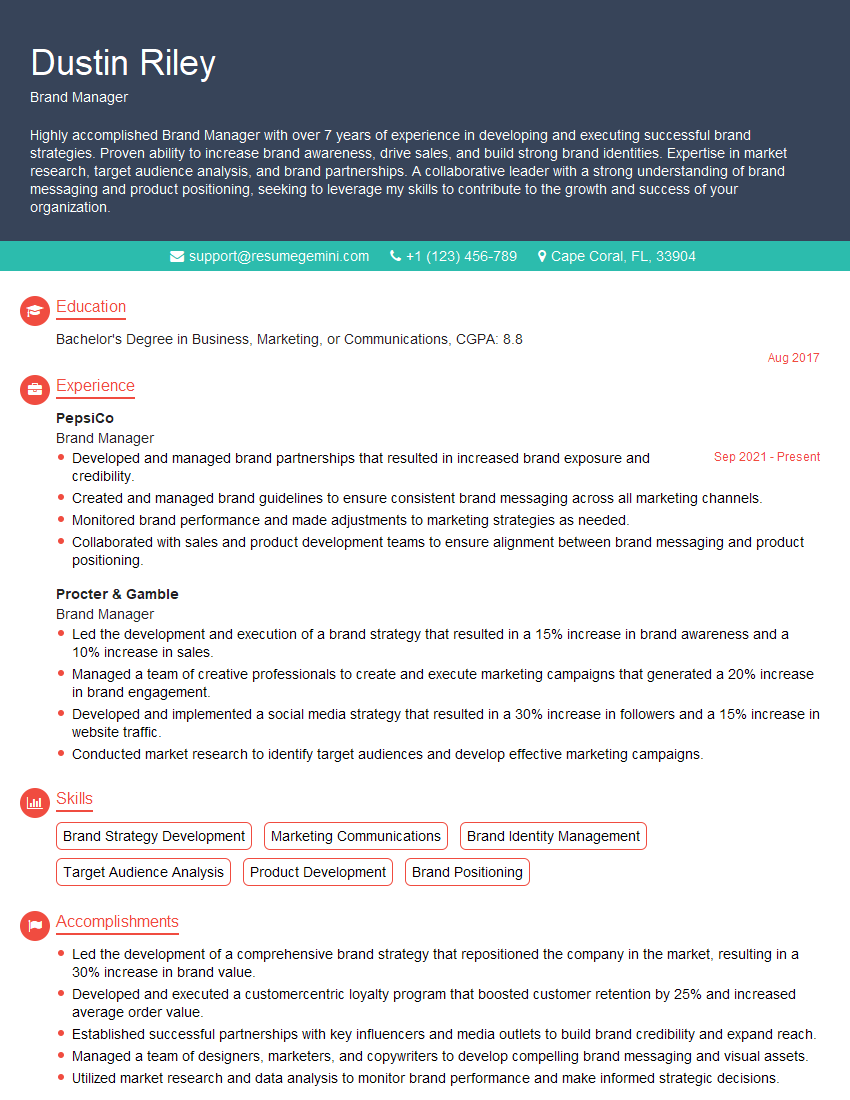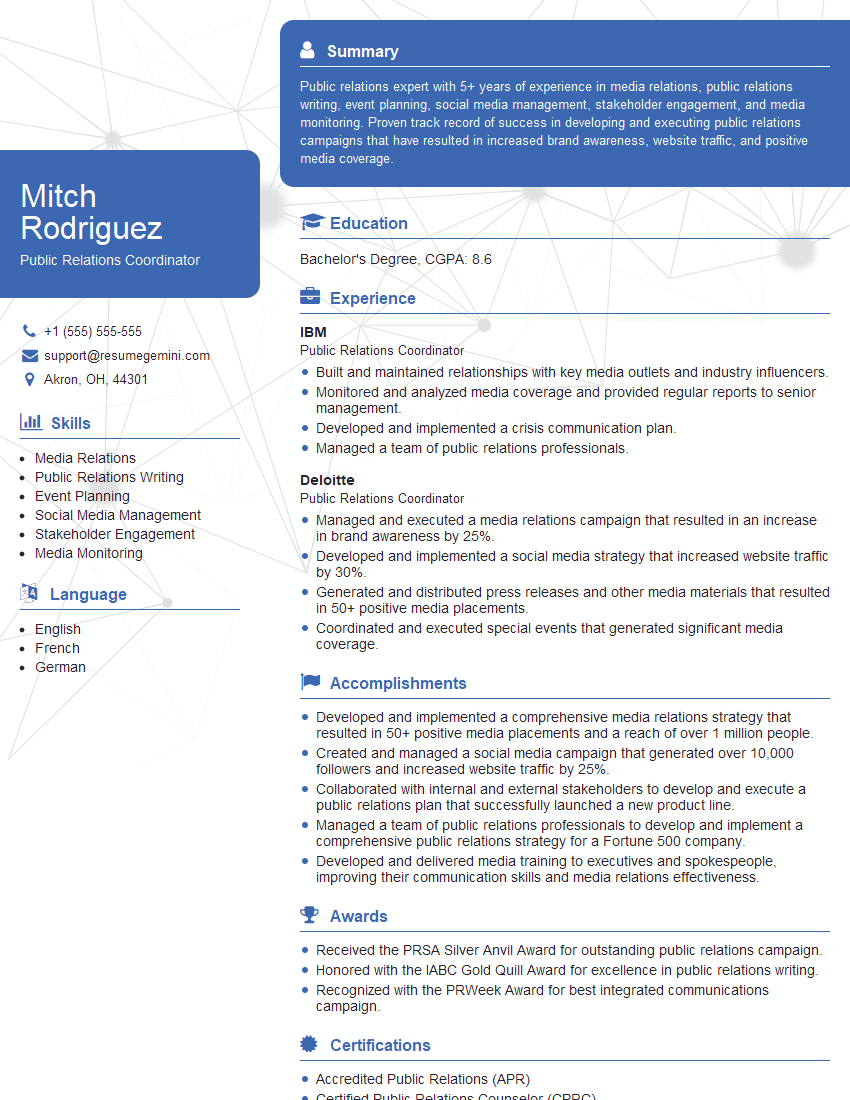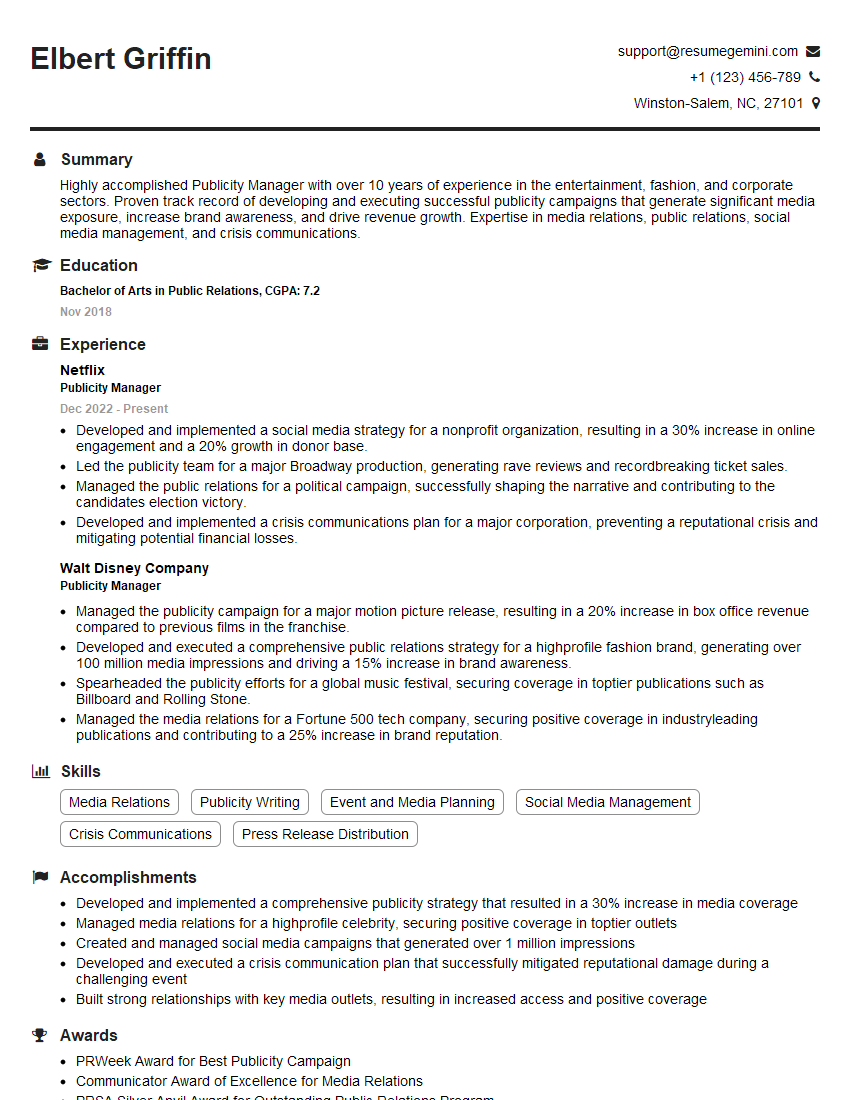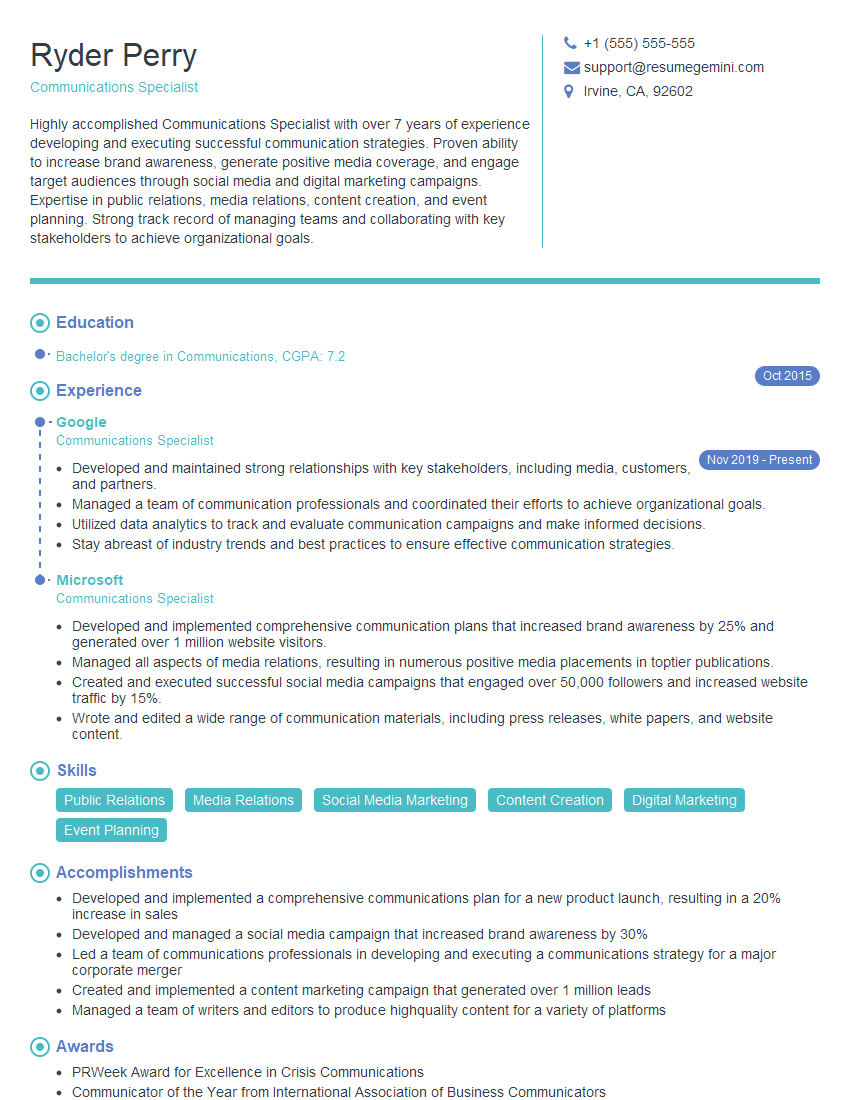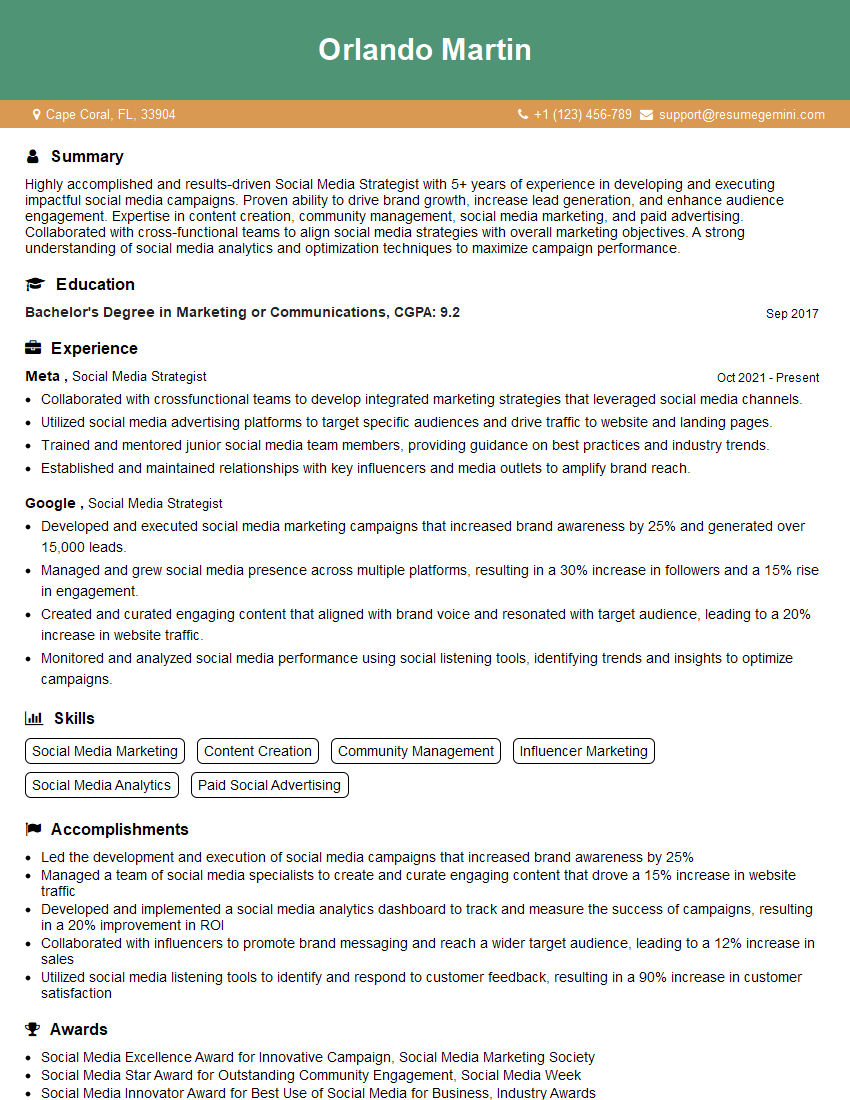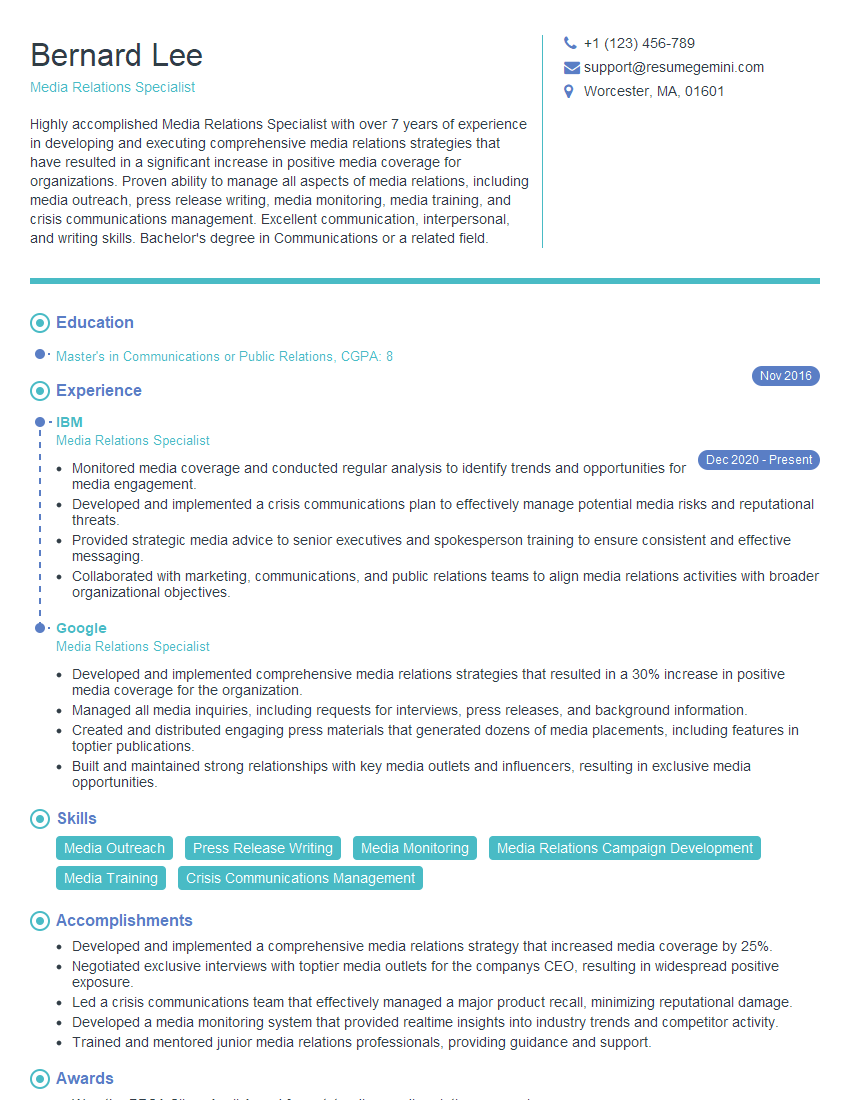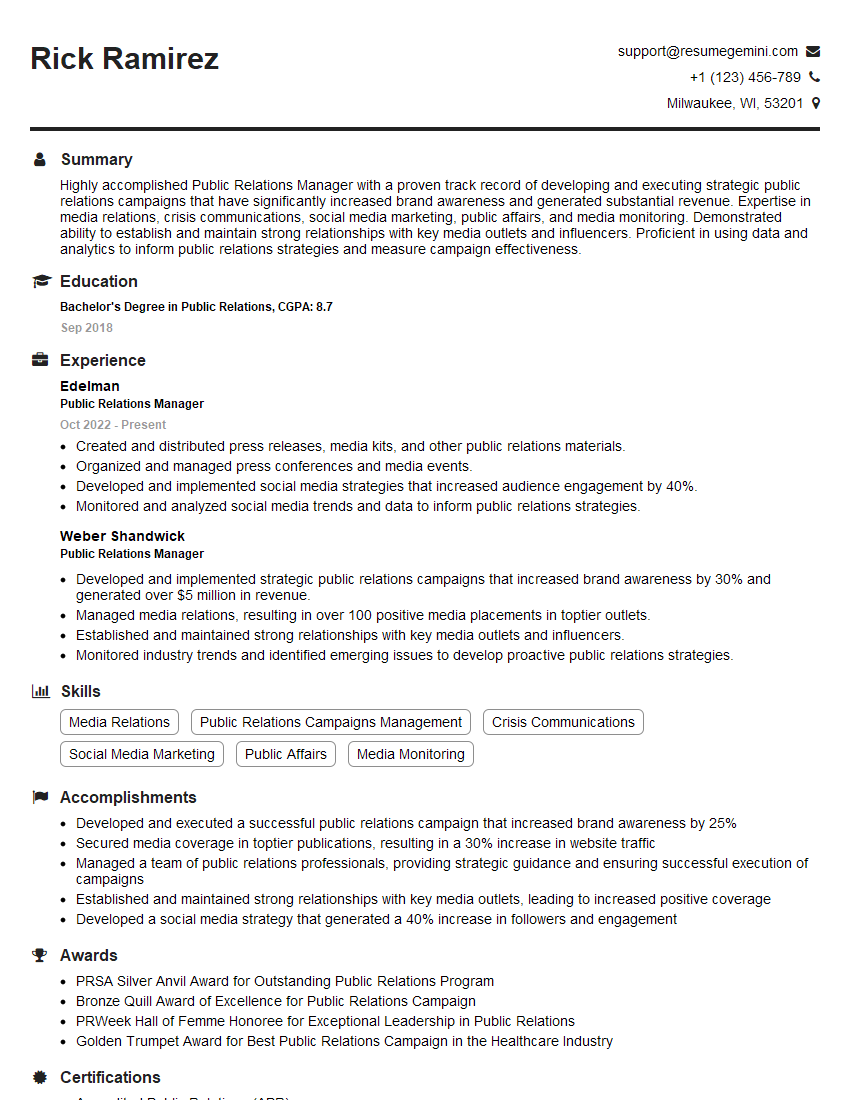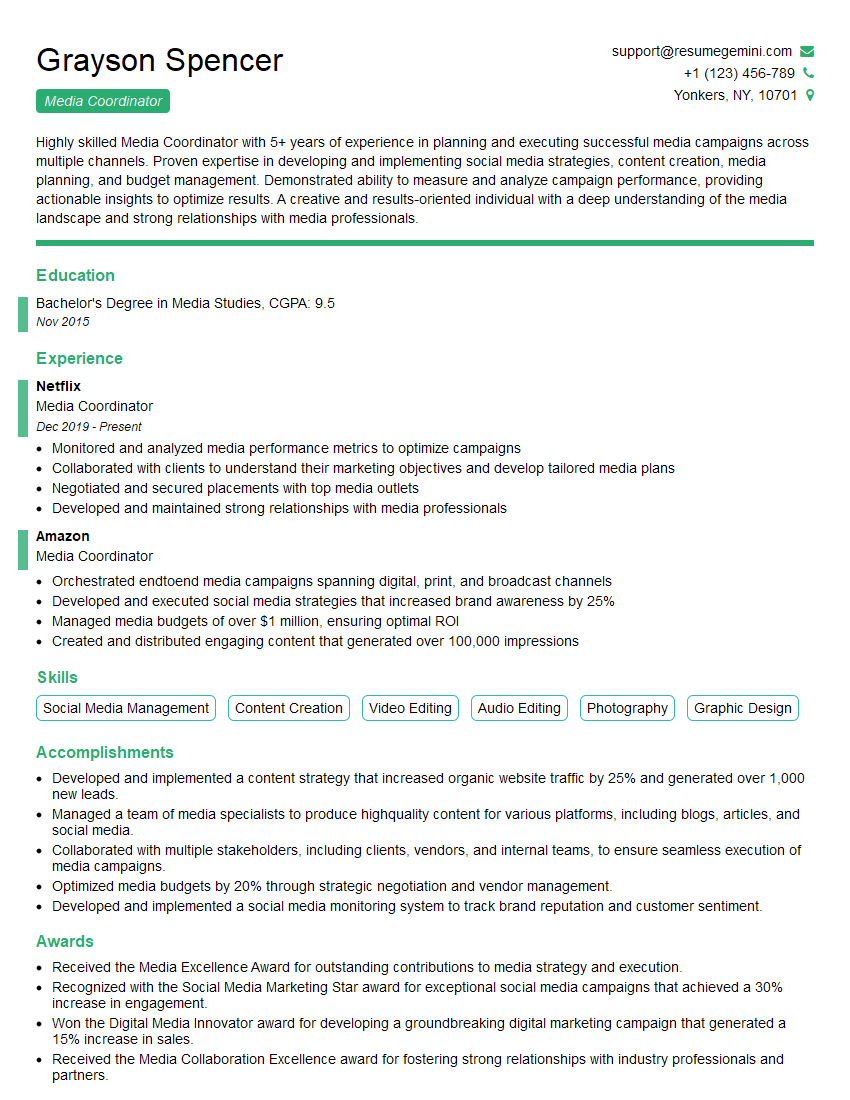Preparation is the key to success in any interview. In this post, we’ll explore crucial Public relations and media coordination interview questions and equip you with strategies to craft impactful answers. Whether you’re a beginner or a pro, these tips will elevate your preparation.
Questions Asked in Public relations and media coordination Interview
Q 1. Describe your experience with media pitching and securing placements.
Media pitching is the art of crafting compelling narratives and distributing them to journalists and media outlets to secure coverage. My experience spans several years, encompassing diverse industries from technology to non-profit. I’ve developed and executed successful pitching strategies that resulted in significant media placements across various platforms, including print, broadcast, and online publications. For example, while working with a tech startup, I crafted a press release announcing their new software, highlighting its unique features and benefits. This resulted in positive coverage in key tech publications, leading to a significant increase in website traffic and brand awareness. Another successful pitch involved securing an interview on a national television show for the CEO of a non-profit organization, elevating their profile and securing significant funding.
My approach is multifaceted. It starts with thorough research to identify the most relevant journalists and outlets. I then tailor the pitch to each specific publication and reporter, highlighting the unique angle of the story that aligns with their editorial focus. Following up strategically after the initial pitch is crucial. Persuasion and building relationships are just as important as the pitch itself.
Q 2. How do you measure the success of a PR campaign?
Measuring the success of a PR campaign requires a multi-faceted approach, going beyond simple media mentions. We use a combination of quantitative and qualitative metrics. Quantitative metrics include:
- Media Mentions: Total number of articles, news segments, or social media posts mentioning the client.
- Reach: Total audience reached through media coverage (estimated based on publication readership/viewership).
- Website Traffic: Increase in website traffic directly attributable to PR efforts.
- Social Media Engagement: Likes, shares, comments, and retweets related to campaign messaging.
- Sales/Leads: Increase in sales or leads directly correlated to campaign activities.
Qualitative metrics are equally important and involve:
- Brand Sentiment: Analyzing the tone of media coverage (positive, negative, or neutral).
- Share of Voice: Measuring the client’s presence compared to competitors.
- Reputation Management: Tracking how the campaign affected the client’s overall reputation.
- Stakeholder Feedback: Gathering feedback from clients, employees, and other stakeholders on the campaign’s effectiveness.
Ultimately, success is measured by achieving the campaign objectives, whether that’s increasing brand awareness, generating leads, or improving public perception.
Q 3. Explain your crisis communication strategy and experience.
A robust crisis communication strategy is crucial for mitigating damage during unexpected events. My approach involves a proactive, multi-stage plan focusing on speed, transparency, and empathy. First, we establish a rapid response team to handle initial communications and information gathering. Then we assess the situation, identifying the key issues, stakeholders affected, and potential impact. Next, we develop a clear and consistent message to address the crisis head-on, acknowledging any problems and outlining steps being taken to rectify them. This message is disseminated across all relevant channels—website, social media, press releases—simultaneously. It’s essential to be transparent and empathetic in our communications, acknowledging concerns and demonstrating accountability.
For instance, during a product recall crisis for a client, we immediately issued a press release acknowledging the issue, outlining the steps taken to address it (e.g., identifying the affected products and offering refunds), and provided contact information for customer support. We actively monitored social media for concerns and responded promptly, demonstrating empathy and commitment to resolving the situation. The rapid response and transparent communication prevented further damage to the client’s reputation and minimized financial losses.
Q 4. What social media platforms are you most proficient in and how have you utilized them for PR?
I am highly proficient in using Twitter, LinkedIn, Facebook, and Instagram for PR purposes. Each platform requires a tailored approach. Twitter is excellent for real-time updates and engaging with journalists and influencers; LinkedIn, for B2B communication and thought leadership content; Facebook for broader audience engagement; and Instagram for visual storytelling and connecting with a younger demographic.
For example, when launching a new product for a client, we used a multi-platform strategy. Twitter served as a platform for quick announcements and live Q&A sessions with the product team. LinkedIn was used to share in-depth articles and white papers explaining the technical aspects of the product. We created engaging visuals on Instagram and Facebook, highlighting user testimonials and showcasing the product in action. This coordinated approach resulted in a strong media buzz and positive customer response.
Q 5. Describe your experience with building and maintaining media relationships.
Building and maintaining strong media relationships is fundamental to successful PR. It’s about establishing trust, providing value, and fostering mutual respect. This is an ongoing process. I regularly connect with journalists, editors, and influencers in my network, providing them with relevant information, exclusives, and insights relevant to their areas of expertise. This might include offering interviews with key personnel, providing data for articles, or sharing industry news.
I personalize my outreach, understanding the individual journalist’s beat and interests. I’m careful not to be overly promotional. Instead, I focus on building rapport through genuine communication and demonstrating my understanding of their needs and deadlines. Building a strong reputation for reliability, providing accurate information, and being responsive significantly contributes to fostering long-lasting relationships. This ultimately makes it easier to secure media coverage when opportunities arise.
Q 6. How do you develop and implement a PR plan?
Developing and implementing a PR plan involves a structured, strategic process. It begins with a clear understanding of the client’s objectives, target audience, and key messages. This is followed by thorough research to identify relevant media outlets and influencers. Next, we define key performance indicators (KPIs) to measure the campaign’s success. A detailed timeline outlining specific tactics (press releases, media pitches, social media campaigns, etc.) is essential. We also allocate resources (budget, personnel) accordingly.
Throughout the campaign, we monitor progress against KPIs, making necessary adjustments as needed. This iterative process ensures that we’re continually optimizing the campaign to achieve the desired results. For instance, I once developed a PR plan for a non-profit organization aimed at increasing volunteer recruitment. The plan incorporated social media campaigns, community outreach events, and targeted media pitches to local news outlets. We tracked volunteer sign-ups, social media engagement, and media mentions to measure success and made adjustments based on real-time data.
Q 7. What is your experience with media monitoring and analysis tools?
I have extensive experience using a range of media monitoring and analysis tools, including Cision, Meltwater, and Brandwatch. These tools allow us to track media mentions, analyze brand sentiment, and measure the impact of our PR efforts. For example, Cision enables us to track mentions across a wide range of media sources, including print, broadcast, and online publications. Meltwater helps us analyze the sentiment of media coverage, giving us valuable insights into how the public perceives our client. Brandwatch is excellent for social listening and identifying emerging trends that may impact the client’s reputation. These tools provide data-driven insights that inform our strategies and help us demonstrate the ROI of our PR campaigns.
Beyond the software, I also employ a rigorous manual process. We supplement the automated data with a thorough review of key publications and online sources to ensure we capture the full scope of media coverage and identify potential issues proactively.
Q 8. How do you handle negative media coverage?
Handling negative media coverage requires a swift, transparent, and strategic response. It’s not about ignoring the issue but about mitigating its impact and regaining public trust. My approach involves:
- Immediate Assessment: Quickly analyze the negative coverage to understand its scope, accuracy, and potential impact. This includes identifying the source, the audience reached, and the overall sentiment.
- Internal Communication: Collaborate with the relevant stakeholders within the organization to develop a unified response strategy. Transparency and honesty are crucial internally.
- Crafting a Response: Develop a response that addresses the concerns directly, acknowledges any mistakes, and expresses empathy. This could be a press release, a statement on social media, or a direct communication to the media outlet.
- Proactive Engagement: Reach out to journalists, bloggers, and influencers to provide further context and correct inaccuracies. A well-placed interview or an opinion piece can help counter the negative narrative.
- Monitoring and Evaluation: Continuously monitor the media landscape to track the impact of the response and adjust the strategy as needed. This allows for agile adaptation based on public reaction.
For example, I once managed a situation where a client faced criticism for a product recall. By proactively engaging with the media, providing transparent explanations about the recall process, and emphasizing the client’s commitment to customer safety, we successfully mitigated the negative impact and maintained a positive brand image.
Q 9. What is your experience with budget management within a PR campaign?
Budget management in PR is crucial for maximizing ROI. My experience encompasses developing detailed budgets, allocating resources strategically, and tracking expenses meticulously. I begin by defining clear objectives and KPIs, which directly inform the budget allocation.
For instance, I’ll break down the budget across different activities: media outreach (including media kits and advertorials), influencer marketing, event planning, content creation, and monitoring and reporting tools. I utilize spreadsheets and project management software to track expenses against allocated funds and proactively identify potential cost overruns.
Negotiating favorable rates with media outlets, vendors, and influencers is also a key part of responsible budget management. For example, I secured a discounted rate for a major media interview by offering an exclusive interview opportunity tied to an upcoming product launch. This approach resulted in significant media coverage at a fraction of the initial quoted cost.
Q 10. How do you track ROI (Return on Investment) for PR efforts?
Tracking ROI in PR is challenging, as the impact isn’t always immediately quantifiable in monetary terms. However, a comprehensive approach involves a mix of quantitative and qualitative metrics.
- Quantitative Metrics: These include media mentions (total number of articles, reach, and impressions), website traffic, social media engagement (likes, shares, comments), lead generation, and sales data (if directly attributable to a PR campaign).
- Qualitative Metrics: These involve brand sentiment analysis (positive, negative, neutral), changes in brand perception (measured through surveys or social listening), and the overall impact on reputation and brand awareness.
I utilize PR analytics dashboards and tools like Google Analytics, social media analytics platforms, and specialized PR software to gather and analyze this data. The choice of metrics will depend heavily on the specific goals and objectives of the PR campaign. For example, a campaign focused on crisis management might prioritize sentiment analysis over lead generation, while a product launch campaign would likely focus on sales and media coverage. Regular reporting and analysis allows for course correction during the campaign and demonstrable ROI at its conclusion.
Q 11. Explain your understanding of different PR writing styles (press releases, etc.).
Different PR writing styles cater to specific audiences and objectives. Understanding the nuances is crucial for effective communication.
- Press Releases: These are factual and concise announcements distributed to media outlets. They follow the inverted pyramid style, starting with the most important information followed by supporting details.
- Feature Articles: These are longer-form articles aimed at providing deeper insight into a topic. They focus on storytelling and engaging the reader with details and context.
- Blog Posts: These are informal and conversational pieces used to engage audiences on a particular topic. They often include SEO keywords and are designed to be shareable on social media.
- Social Media Posts: These are short and attention-grabbing updates aimed at driving engagement on social media platforms. They use concise language and are adapted to the specific platform’s characteristics.
- Speeches and Presentations: These are crafted to resonate with a live audience, focusing on strong messaging and a compelling narrative.
My experience involves adapting these styles based on the context and desired outcome. For example, a press release announcing a merger will be different in tone and content from a blog post aimed at attracting potential customers.
Q 12. Describe your process for identifying key media outlets and influencers.
Identifying key media outlets and influencers is a crucial step in any PR campaign. My process involves:
- Target Audience Analysis: Understanding the target audience’s media consumption habits is fundamental. What publications do they read? Which social media platforms do they use? Who are their trusted sources of information?
- Media Database Research: I leverage media databases (e.g., Cision, Meltwater) to identify relevant journalists, bloggers, and influencers who cover the industry or topic.
- Social Listening: I use social listening tools to identify influential voices within the relevant online communities. This helps in recognizing unexpected influencers who may not be covered by traditional media databases.
- Media Kit Preparation: I create a comprehensive media kit that includes information about the client, relevant case studies, and high-quality visuals to facilitate media outreach.
- Relationship Building: Cultivating relationships with journalists and influencers is essential for long-term success. This requires regular communication, sharing relevant information, and demonstrating value.
For example, in a recent campaign for a tech startup, I identified several niche technology bloggers and podcasts as key influencers. By targeting them with personalized pitches and providing exclusive content, we secured significant coverage and increased brand awareness within the target audience.
Q 13. How do you adapt your PR strategy to different target audiences?
Adapting PR strategies to different target audiences is essential for effectiveness. Each audience has unique characteristics, media consumption habits, and communication preferences.
For example, a campaign targeting millennials will differ significantly from one targeting Baby Boomers. Millennials are more likely to engage with social media and prefer visually appealing content, while Baby Boomers may be more receptive to traditional media channels like print publications and television.
My approach involves tailoring the message, tone, and channels used to resonate with each specific audience segment. This includes using appropriate language, visuals, and platforms. For example, using emojis and short, impactful sentences on Instagram might be suitable for a younger demographic, while a more formal tone and longer-form content might be appropriate for a professional publication read by a more established demographic.
Q 14. Describe your experience using PR analytics and reporting dashboards.
I have extensive experience using PR analytics and reporting dashboards to track campaign performance and demonstrate ROI. Tools like Cision, Meltwater, and social media analytics platforms provide valuable insights into media coverage, social media engagement, and brand sentiment.
These dashboards allow me to monitor key metrics in real-time, such as media mentions, reach, impressions, website traffic, and social media engagement. This data is then used to create comprehensive reports that demonstrate the impact of PR efforts and identify areas for improvement. For example, I might use data from a dashboard to show a client how a specific PR campaign increased brand awareness by X% or generated Y number of leads.
Visualizations, such as charts and graphs, are integral to presenting this data clearly and concisely to clients. These reports not only demonstrate success but also inform future strategy and demonstrate the value of the PR function to the organization.
Q 15. Explain your experience with internal communications.
Effective internal communications are crucial for a cohesive and productive work environment. My experience encompasses developing and implementing strategies to keep employees informed, engaged, and aligned with the organization’s goals. This includes crafting compelling internal newsletters, utilizing intranet platforms for updates and announcements, organizing town hall meetings for open dialogue with leadership, and creating targeted communication plans for specific projects or initiatives. For example, at my previous role at [Previous Company Name], I spearheaded an internal communications campaign to announce a major company restructuring. This involved a multi-pronged approach including email announcements, a series of FAQs to address employee concerns, and one-on-one meetings with departmental heads to ensure a smooth transition and address any anxieties proactively. The result was a significant reduction in employee anxiety and a smoother transition than initially anticipated.
Career Expert Tips:
- Ace those interviews! Prepare effectively by reviewing the Top 50 Most Common Interview Questions on ResumeGemini.
- Navigate your job search with confidence! Explore a wide range of Career Tips on ResumeGemini. Learn about common challenges and recommendations to overcome them.
- Craft the perfect resume! Master the Art of Resume Writing with ResumeGemini’s guide. Showcase your unique qualifications and achievements effectively.
- Don’t miss out on holiday savings! Build your dream resume with ResumeGemini’s ATS optimized templates.
Q 16. How do you manage multiple projects and deadlines simultaneously?
Managing multiple projects and deadlines effectively requires a strategic and organized approach. I utilize project management tools like Asana or Trello to track tasks, deadlines, and team progress. I prioritize tasks based on urgency and importance, employing methods like the Eisenhower Matrix (urgent/important). Furthermore, I maintain clear communication with all stakeholders, providing regular updates on progress and proactively addressing any potential roadblocks. Think of it like conducting an orchestra – each instrument (project) needs to be carefully timed and coordinated to create a harmonious whole (successful outcome). Detailed planning and consistent communication are key to preventing conflicts and ensuring timely completion.
Q 17. Describe a time you had to overcome a significant challenge in a PR campaign.
During a campaign promoting a new product launch, we faced a significant challenge when a negative review went viral online, incorrectly alleging safety concerns. This threatened to derail our entire launch strategy. My immediate response involved a two-pronged approach: First, we swiftly investigated the claims, working with the product development team to verify the product’s safety and gather evidence to refute the false claims. Secondly, we developed a proactive communication strategy to directly address the concerns. We issued a press release clarifying the situation and outlining our commitment to product safety, contacted key influencers to correct the misinformation, and directly engaged with consumers online, responding to comments and concerns with transparency and empathy. The situation was successfully resolved, demonstrating the importance of swift, decisive action, and the power of open communication in crisis management.
Q 18. How do you integrate PR strategies with marketing and sales objectives?
PR, marketing, and sales are interconnected elements of a holistic business strategy. PR builds brand awareness and credibility, marketing drives customer engagement and lead generation, and sales converts leads into customers. I integrate these strategies by aligning messaging across all platforms, ensuring consistent branding and a cohesive customer journey. For example, a successful product launch would involve a PR campaign to generate media coverage and build excitement, a targeted marketing campaign to reach potential customers, and a well-trained sales team ready to convert leads. I ensure that the PR activities amplify the marketing and sales messages, working collaboratively to optimize the overall impact and maximize ROI.
Q 19. What is your experience with reputation management?
Reputation management is a critical aspect of PR, focusing on protecting and enhancing an organization’s image. My experience includes developing and implementing strategies to proactively manage online reputation, monitor brand mentions across various platforms, respond to online reviews and comments, and address potential crises effectively. I employ tools for social media listening and sentiment analysis to identify and address potential issues before they escalate. In one instance, I successfully navigated a negative social media trend by proactively engaging with concerned parties, demonstrating transparency and empathy, and ultimately turning the negative sentiment into a positive outcome. This involved actively monitoring social channels, crafting empathetic responses, and collaborating with internal teams to develop solutions addressing customer complaints.
Q 20. How do you collaborate effectively with other teams (marketing, sales, etc.)?
Effective collaboration is essential for successful PR campaigns. I foster collaborative relationships with other teams by maintaining open communication channels, establishing clear roles and responsibilities, and sharing regular progress updates. I prioritize active listening and incorporate feedback from different teams into the PR strategy. This collaborative approach ensures that the PR activities align with the overall business goals and leverage the expertise of various departments. For example, I frequently participate in cross-functional meetings with marketing and sales teams to align messaging, coordinate activities, and ensure a cohesive approach to reach our target audience.
Q 21. What experience do you have with event planning and media coverage for those events?
I have extensive experience in event planning and media coverage for events ranging from press conferences and product launches to industry conferences and award ceremonies. This includes developing a comprehensive event strategy that includes media outreach, securing media attendance, creating compelling press kits, managing on-site media relations, and post-event follow-up. For example, at [Previous Company Name], I planned and executed a major industry conference that generated significant media coverage and increased brand awareness. This involved identifying key media outlets, crafting targeted press releases, securing interviews with senior executives, and managing media relations on-site. Post-event, I analyzed media coverage to evaluate the campaign’s effectiveness and identify areas for improvement. The successful media coverage resulted in significant brand exposure and helped establish the company as a leader in the industry.
Q 22. How familiar are you with different types of media (print, broadcast, digital)?
My familiarity with different media types is extensive and spans print, broadcast, and digital channels. I understand the nuances of each, recognizing their unique strengths and limitations in reaching target audiences.
- Print Media: I’m proficient in crafting press releases, op-eds, and feature articles tailored for newspapers, magazines, and trade publications. I understand the importance of concise writing and impactful visuals in this space. For example, I successfully secured coverage in the *Wall Street Journal* for a client’s new product launch by crafting a compelling narrative focused on its unique market advantage.
- Broadcast Media: I have experience working with television and radio, including developing compelling sound bites and pitching stories to producers. I understand the time constraints and visual storytelling requirements of this medium. A recent success involved securing a segment on a national morning show to discuss a client’s charitable initiative.
- Digital Media: I’m adept at leveraging online platforms like social media, email marketing, and websites to build brand awareness and engage audiences. This includes managing social media campaigns, creating engaging online content, and utilizing SEO best practices. For example, I implemented a comprehensive social media strategy for a client that resulted in a 30% increase in engagement within three months.
Q 23. What are some of the ethical considerations in public relations?
Ethical considerations are paramount in public relations. Transparency, accuracy, and fairness form the cornerstone of my professional practice.
- Transparency: I believe in full disclosure of client relationships and potential conflicts of interest. This includes clearly identifying sponsored content and avoiding any deceptive practices.
- Accuracy: I meticulously fact-check all information before disseminating it to the public. This includes verifying statistics, quotes, and other details to ensure accuracy and avoid misinformation.
- Fairness: I strive to present information objectively and avoid manipulating or distorting facts to favor a particular narrative. I respect the viewpoints of all stakeholders and engage in honest and respectful communication.
- Confidentiality: Protecting client information and respecting privacy is essential. This includes the responsible handling of sensitive information shared during the client-agency relationship.
For instance, I once had to advise a client against releasing potentially misleading information about a product, even though it might have garnered immediate positive media attention. Maintaining ethical integrity is always prioritized over short-term gains.
Q 24. How do you utilize media databases and contact lists?
Media databases and contact lists are crucial tools in my workflow. I utilize them to identify relevant journalists, bloggers, and influencers for targeted media outreach.
I regularly use Cision and Meltwater, for example, to identify journalists covering specific beats relevant to my clients’ industries. I segment these lists by media outlet, beat, and other relevant factors to ensure personalized outreach. My process involves:
- Identifying Target Media: Researching the most appropriate outlets for my client’s message based on audience demographics, editorial focus, and reach.
- Building Contact Lists: Compiling a comprehensive list of media contacts, including their email addresses, phone numbers, and social media handles.
- Personalizing Outreach: Tailoring my pitches to individual journalists and editors, highlighting the aspects of the story most relevant to their audience.
- Tracking Results: Monitoring media coverage and analyzing the effectiveness of my outreach efforts.
This targeted approach helps to increase the chances of securing media coverage and maximizing the impact of my PR campaigns.
Q 25. What experience do you have with influencer marketing?
I have significant experience with influencer marketing, recognizing its power in reaching niche audiences and driving engagement. My approach emphasizes collaboration and authenticity.
I’ve successfully implemented campaigns across various platforms, including Instagram, TikTok, and YouTube. My strategy typically involves:
- Identifying Relevant Influencers: Researching influencers who align with my clients’ brand values and target audiences.
- Developing Campaign Strategies: Creating engaging content that resonates with the influencers’ audiences while maintaining a genuine brand voice.
- Managing Influencer Relationships: Building strong relationships with influencers to foster long-term collaboration.
- Measuring Campaign Performance: Tracking key metrics such as reach, engagement, and website traffic to assess the campaign’s effectiveness.
For example, I collaborated with a food blogger to promote a new line of organic snacks, resulting in a significant increase in sales and brand awareness. Success in influencer marketing depends on finding the right partners and crafting authentic, engaging content.
Q 26. Explain your familiarity with AP style or other style guides.
I’m proficient in AP style and other relevant style guides. Consistent adherence to style guidelines ensures clarity, accuracy, and professionalism in all communications.
Understanding AP style, for instance, guarantees consistent formatting, punctuation, and capitalization in press releases and other media materials. This is critical for maintaining credibility and avoiding errors that could damage a client’s reputation. I also adapt to other style guides as needed, such as Chicago or MLA, depending on the specific publication or client requirements. Consistent application of style guides streamlines the editing process and ensures a polished final product.
Q 27. How do you stay up-to-date on current trends in the PR industry?
Staying abreast of current PR trends requires a multifaceted approach. I actively engage with industry publications, attend conferences, and participate in online communities.
- Industry Publications: I regularly read publications like *PR Week*, *PR Daily*, and *The Holmes Report* to stay updated on industry news and best practices.
- Conferences and Webinars: Attending industry conferences and webinars allows me to network with other professionals and learn about new technologies and strategies.
- Online Communities: Participating in online forums and groups dedicated to public relations keeps me connected to the latest discussions and trends.
- Continuous Learning: I actively pursue professional development opportunities to enhance my skillset and stay ahead of the curve.
This commitment to continuous learning is crucial in a dynamic field like public relations, ensuring that I can leverage the most effective strategies for my clients.
Q 28. Describe your experience with content creation for PR purposes.
Content creation is a core component of my PR work. I develop various content types, including press releases, blog posts, social media updates, website copy, and speeches, all tailored to specific PR objectives.
My content creation process involves:
- Understanding the Client’s Goals: Clearly defining the objectives of the PR campaign and identifying the target audience.
- Conducting Research: Gathering relevant information to inform the content and ensure accuracy.
- Developing a Content Strategy: Planning the types of content to be created and the platforms for distribution.
- Creating Compelling Content: Writing engaging and informative content that resonates with the target audience and achieves the campaign’s objectives.
- Optimizing for Distribution: Formatting and tailoring content to suit different platforms and optimizing for SEO and social media engagement.
For example, I recently wrote a series of blog posts for a tech company that explained complex technical concepts in a simple and engaging way, which led to increased website traffic and brand authority. Effective content creation is key to building brand awareness, engaging stakeholders and achieving PR goals.
Key Topics to Learn for Public Relations and Media Coordination Interviews
- Media Relations: Understanding media landscapes (print, digital, broadcast), crafting compelling press releases, building and maintaining relationships with journalists, and handling media inquiries effectively.
- Crisis Communication: Developing and implementing crisis communication plans, managing reputation during challenging situations, and effectively communicating with stakeholders.
- Publicity and Promotion: Developing and executing strategies to generate positive media coverage and public awareness, utilizing various promotional channels and tools.
- Social Media Management: Developing and implementing social media strategies, engaging with audiences online, monitoring social media conversations, and managing online reputation.
- Content Creation: Crafting engaging content for various platforms (press releases, website copy, social media posts, blog articles) that aligns with communication objectives.
- Event Planning and Management: Organizing and executing successful press events, conferences, and other public relations activities.
- Measurement and Reporting: Tracking key performance indicators (KPIs), analyzing results, and reporting on the effectiveness of public relations campaigns.
- Strategic Communication Planning: Developing comprehensive communication strategies that align with organizational goals and target audience needs. This includes understanding target audiences and crafting messages that resonate.
- Ethical Considerations: Understanding and applying ethical principles in public relations practices, including transparency, accuracy, and accountability.
- Problem-Solving & Decision-Making under Pressure: Demonstrating your ability to handle unexpected situations, make quick decisions, and effectively manage conflicting priorities. This often involves creative solutions to communication challenges.
Next Steps
Mastering public relations and media coordination opens doors to exciting career opportunities and significant professional growth. A strong understanding of these skills is highly sought after across various industries. To maximize your job prospects, creating an ATS-friendly resume is crucial. This ensures your application gets noticed by recruiters and hiring managers. We highly recommend using ResumeGemini to build a professional, impactful resume that highlights your skills and experience effectively. ResumeGemini provides examples of resumes tailored to public relations and media coordination roles, helping you craft a compelling application that stands out.
Explore more articles
Users Rating of Our Blogs
Share Your Experience
We value your feedback! Please rate our content and share your thoughts (optional).
What Readers Say About Our Blog
Interesting Article, I liked the depth of knowledge you’ve shared.
Helpful, thanks for sharing.
Hi, I represent a social media marketing agency and liked your blog
Hi, I represent an SEO company that specialises in getting you AI citations and higher rankings on Google. I’d like to offer you a 100% free SEO audit for your website. Would you be interested?
